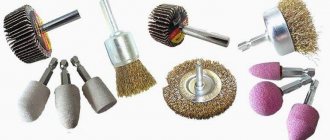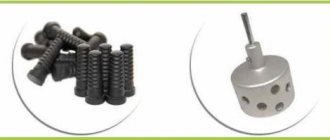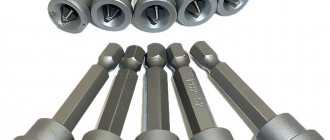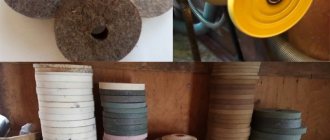Attachments for drills, screwdrivers and grinders for polishing cars - types and their choice
All car owners value their vehicle. Some even associate a car with their second home. All car enthusiasts are especially sensitive to the appearance and condition of the car. Even minor scratches and damage can ruin the mood of the car owner.
Why do you need to polish a car body?
But how can you make your car look more attractive and presentable? One way to maintain a presentable form of transport is by polishing. Polishing removes scratches, small chips and other subtle defects. The basic concept of polishing is that car mechanics remove a thin layer of paintwork. This allows you to get rid of scratches and chips, as well as return the car to a fresh, presentable look without damaging the paintwork.
Advantages of the method
Such a low-cost and accessible method for every car enthusiast will allow not only corrections for minor damage, but also giving the car a well-groomed appearance. The technology is simple, and it won’t be difficult to do all the work yourself. In this way, headlights, bumpers and windows can be perfected.
When processing headlights, do not use silicone polishes. In some cases, it may be necessary to treat the headlight glasses with sandpaper R 600-800, it all depends on their original condition.
Types of polishing work
Restorative polishing is divided into soft and deep. They differ only in the degree of varnish removal. Soft polishing removes a relatively small layer of paintwork. This is enough to hide the “spider web” effect or save the car from minor scratches. For deeper defects, it is better to use deep polishing, which will cope with scratches, small chips, etc.
Final part
Today, it is impossible to imagine modern production without the use of an angle grinder, and almost every household owner has this technical device in their garage. Its use is multifunctional, and is applicable for any type of work, both repair and for the manufacture or processing of any assembly unit or product. Attachments for angle grinders also have different functions, which allows them to be used in different directions. Therefore, it is not necessary to contact a repair shop, and you can do most of the work yourself.
Equipment types
Several types of equipment are used in polishing. Firstly, these are rotary polishers. They come in different types, sizes, capacities, etc. However, by and large, they are all the same. All modern rotary polishers have several speed levels and replaceable polishing plates. They constantly maintain the same speed, the nozzles rotate in a circle.
In addition, eccentric sanders can be found in auto repair shops. This type of grinder has several types. In fact, they differ only in the rotation of the disk.
This equipment is professional. If you decide to polish the car yourself, then a drill, screwdriver or grinder may be enough for you.
When polishing, what matters most is not so much the tool you use, but the polishing attachment and, of course, a certain skill in polishing.
Milling
Milling attachments are produced in various designs; a distinctive feature is the size of the abrasive grains. According to their intended purpose during work, such attachments are similar to rasps; the use of an angle grinder allows you to increase the speed of processing the material. Craftsmen use these devices for final processing of wood.
Milling cutter for grinder
Special cutters are produced, there is an abundance of assortment on the market, each tool differs in purpose and features. Main areas of application:
- preliminary alignment of edges;
- sawing or cutting out a bowl from small-section blanks;
- groove sampling.
When working with milling and grinding attachments with a grinder, it is prohibited to remove the protective device - the tool casing. Each tool has a technical purpose and instructions, which clearly describe the materials suitable for use and the operating modes of the tool.
Types of polishing attachments
After we have understood the theoretical part a little, we should move on to the next point, which will help us figure out what type of polishing attachments to use and when.
It is worth noting that each detailing center has its own approach and, as a result, its own preferences in polishing attachments. The universal pattern by which you should polish your car must be created by you yourself, based on your personal preferences.
Polishing attachments are divided into groups according to several principles.
They are divided by appearance: surface grinding and flap grinding. And also according to the degree of hardness:
- With a relief surface;
- Medium hardness;
- With high rigidity.
Finally, they are divided according to the type of materials from which they were made. Below we will look at polishing discs made from different materials, their pros and cons, and also help car enthusiasts decide on the choice of attachment to polish their car at home.
Felt or felt car polishing supplies
Felt or felt polishing discs are often used to process metal body surfaces. Felt polishing discs come in three types and are divided according to the thickness of the wool - thick, medium and fine. The choice of wheel depends on the type of work being carried out, so it is important to select the required disk when processing metal. The least common are discs with fine wool. They are used either for surface cleaning or during polishing of non-ferrous metals. Felt discs with medium and thick wool are used more often. Medium wool thickness is preferable for minor repair work - barely noticeable cracks, small chips, etc. Thick-haired discs are used for deep paintwork processing to remove large scratches.
Sheepskin nozzle for car polishing and its types
Sheepskin wool discs are one of the most common. This is due to both ease of operation and relative low cost compared to analogues. The average person may have the opinion that since the wool is soft, then logically such an attachment should be used in the final stages. However, this does not entirely fit current realities. Some wool discs may leave marks after processing the body, so it is important to choose and take a disc that will suit the type of work you are doing. Also, it should be noted that all wool discs lose the quality of their work if used incorrectly. Pay attention to the required disk rotation speed to avoid unwanted incidents.
Sheepskin attachments for different types of polishing
Let's look at the types of disks and the types of work for which they are used. When polishing, three types of sheepskin discs are often used:
- Twisted pile. Such discs are used for rough processing. Thanks to their properties, twisted pile discs can easily cope with medium-depth scratches and similar defects of the same level of complexity.
- Classic sheepskin discs. Such discs are used at the final stages of car polishing. They are best suited for achieving a high-gloss shine on your car.
- Sheepskin for soft polishing. Such discs are characterized by the most delicate degree of processing. They are used at the final stages of polishing work. Such discs are quite expensive and also have a characteristic yellow coat color.
Advantages and disadvantages of sheepskin polishing discs.
Pros:
- They can easily cope with almost all scratches.
- Low consumption of polishing paste, which increases efficiency in use.
- They do not heat the surface of the body and, as a result, reduce the possibility of incidents and unforeseen situations.
Minuses:
- Cannot be used at the final stage, since such discs leave holograms and small scratches.
- The price of some discs may be higher than that of similar discs made from other materials.
- Should only be used at certain speeds.
Foam polishing attachments types and purposes
Foam polishing attachments, like previous discs, are divided into several types, which are used for certain operations. They are divided into three types:
- Soft. Used at the final stages of polishing work. Thanks to their structure, they can easily cope with the last cleaning of the body.
- Average. They are used by auto repairmen to polish the body and also hide minor defects.
- Tough. During polishing, they are used to remove more noticeable defects: scratches, chips, abrasions, etc.
For the most part, foam discs are used to apply protective and restorative polish. They differ not only in rigidity, the types of which we examined earlier, but also in the shape of the base. You can find two types of such disks:
- With a corrugated base - petal. This type of disc is suitable for soft processing of paintwork. This is due to the fact that such discs have a smaller plane of contact with the surface, which allows for more delicate polishing of the body. This type is preferable when applying certain materials to the surface of the body, as well as when removing holograms. In addition, due to the smaller plane of contact with the surface of the car, it is possible to avoid strong heating of the body.
- Planar ones, in turn, are mostly used for standard polishing work.
Advantages and disadvantages of foam polishing discs.
Pros:
- Variability of choice;
- Cheapness.
Minuses:
- High consumption of polishing paste;
- During polishing, the body becomes very hot.
Fabric polishing pads
This type of attachment is mostly used for manual work of rubbing polishing paste into the paintwork.
For the average motorist
For minor damage, a regular grinder or hand drill will suffice. The processing circles are made of wool or foam rubber. The tool must have a speed regulator to avoid unnecessary scratches and abrasions. The desired type of paste is applied to the circle and a little to the work area.
Polishing should be done crosswise, gradually moving vertically and horizontally. This will allow you to apply the paste evenly and properly treat the surface, the main thing is that the paste does not dry out while working. Polishing is carried out until the desired shine appears. All excess paste is wiped off with a soft cloth or napkin.
After the area is polished, silicone paste is applied and the same actions are carried out with a softer circle. The whole job takes several hours. The final step is to apply a protective layer using a soft cloth or a special mitten. The layer should be distributed evenly so that there is no excess polishing left; all drips should be removed with a napkin.
How to choose a car polishing attachment
We figured out what kind of polishing attachments there are in principle. Now it’s worth summing up and deciding which attachments you should buy for polishing your car at home.
Much depends, of course, on what type of polishing work you plan to carry out. If we are talking about soft polishing, then the nozzles should have a more delicate effect. In the case of deep polishing, it is necessary to use coarser polishing discs. In addition, do not forget that special discs are needed for different types of surfaces. There are no universal discs that are suitable for everything, so it is better to buy several attachments separately that will satisfy all your needs.
Each auto mechanic has his own personal set of discs that he uses in his work. There is no generally accepted set, so everything is determined by trial and error.
However, there are a number of things to consider when purchasing polishing pads.
First of all, you need to pay attention to the rotation speed at which the disks work more efficiently. Manufacturers often indicate this speed directly on the polishing discs. Remember, when working at the wrong speed, the likelihood of damaging the surface of the body increases.
In addition, pay attention to the types of mounting so that the disc will definitely fit your tool and the size of the disc. With a smaller disk size, the convenience of work increases, but the area to be processed decreases, which is why the work time increases. The situation is the opposite when working with a large disk - it is more difficult to process paintwork with it, but the speed of work increases.
And of course you should pay attention to the manufacturer and price. It is better to buy discs from trusted brands. If you choose equipment from little-known or unverified manufacturers, there is a high probability that you will get a defective product that will ruin your paintwork. Don't take risks and buy a nozzle from a reputable manufacturer.
Polishing wheels
| All products Select store | Show: |
| Sort by: Popularity Rating Ascending price Descending price | Show by: 20 40 80 products |
Useful information
To operate an angle grinder, you need special equipment. Polishing wheels clean the surface of old paint, varnish or rust. They are also used for finishing parts.
Selection options
- The diameter is selected depending on the amount of work to be performed and the relief of the parts to be ground. The larger the diameter, the faster you can sand the surface. However, products with recesses, depressions and protruding edges will be more convenient to process with circles of small diameter, for example, 125 mm.
- The type of fastening can be of three types: Velcro, ties and thread. The first method is the most convenient - replacement of equipment is done in just a few seconds. Polishing wheels with ties are most often made of fur (natural or artificial); for example, a sheepskin wheel is very common. They are intended for polishing paint and varnish coatings, for example, car body. Threaded fastening is the most reliable, therefore such equipment is mainly used for long grinding processes, for example, stone surfaces.
- The material used for polishing may also vary. It is selected based on the assigned tasks. For example, abrasive wheels are suitable for removing rust and paint, and fur equipment is suitable for soft polishing.
Reviews of polishing wheels
Manufacturers
Top
Down
www.vseinstrumenti.ru
conclusions
Now that you have figured out how to choose the right car polishing attachments, you can easily carry out your first polishing work. Always remember that this type of work requires a delicate approach. It’s better not to take unnecessary risks and test the nozzle on another surface before use. So, by trial and error, you can create your own list of attachments that you will use in your work. Decide which material is preferable for you: foam rubber, sheepskin wool or felt. And always be mindful of the speed at which you polish the car.
However, to avoid mistakes that could have a negative impact on the condition of your car, it is better to give preference to professional detailing. Experts will quickly select equipment specifically for your case and return your car to its salon appearance without risk.
Preparatory stage
Before starting work, you need to prepare the necessary tools and wash and dry the car. Next, you need to clean insect marks and bitumen stains with a special product.
Polishing the body with a drill should not be carried out outdoors to avoid defects. The work room must be equipped with ventilation and good light, so as not to miss small scratches and roughness.
Foam drill attachment for car polishing











